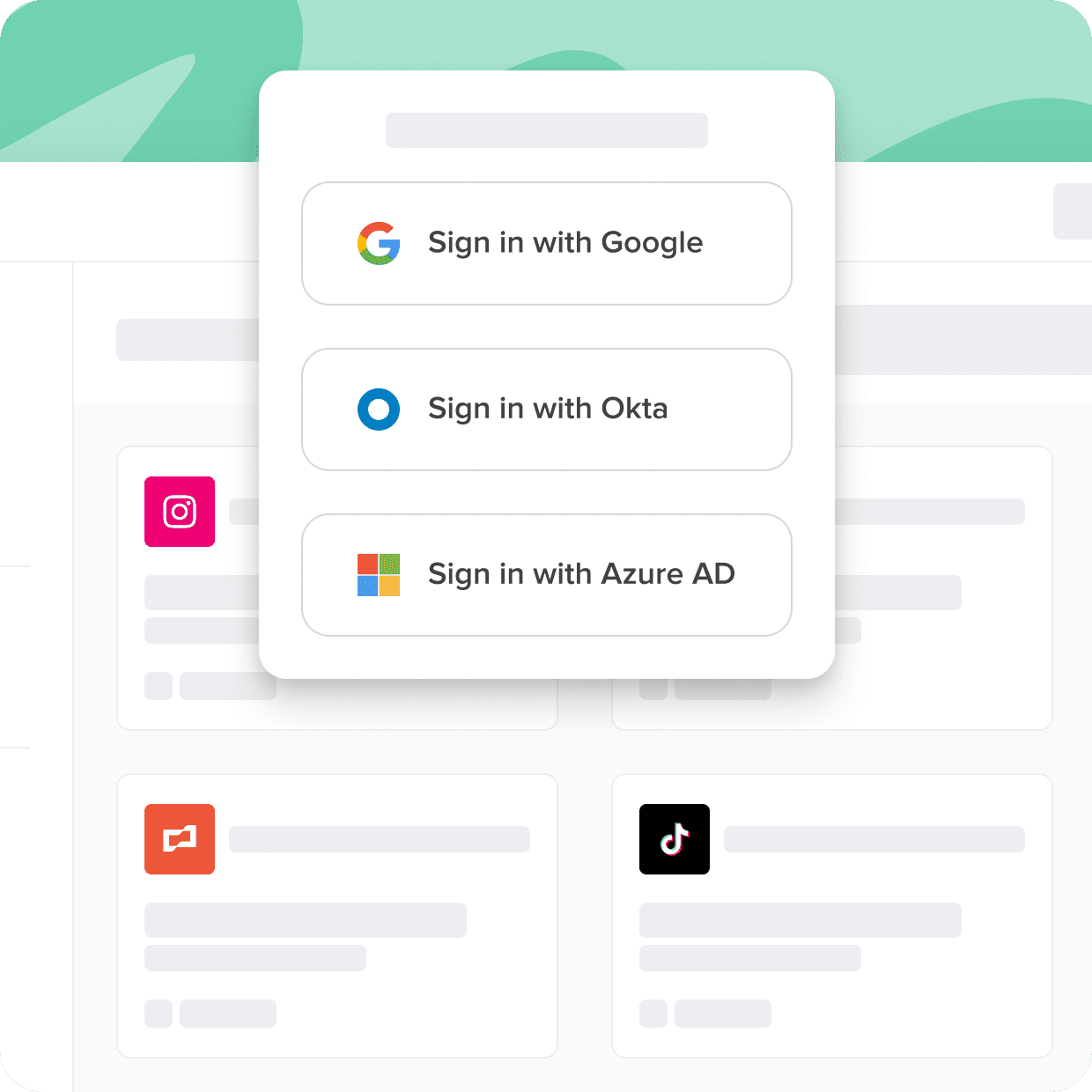Instagram single sign-on (SSO) is a feature that allows users to log in to third-party applications while using their Instagram login credentials, which can eliminate the need for separate account creation. With the integration of SSO, you can enhance your security and control over user access to various applications and resources.
Unfortunately, many corporate applications don't support the SSO standard and can't reap all the benefits. The applications that fall into this category are best called "nonfederated." Nonfederated applications are a new category that is becoming increasingly challenging for businesses to manage and secure effectively, yet increasingly critical for businesses to succeed.
Cerby connects all of your apps to your SSO tools, even if they don't support the SSO standard. In this guide, you'll learn about SSO software, the history, and the benefits.
Streamline Access With Single Sign-On
Not all apps are created equal. Some come with security gaps and complexities that can hinder user adoption and put sensitive data at risk. With Cerby, you can ensure secure and seamless access to all your applications, regardless of their support for standards like SSO.
With Cerby You Can

Close the identity gap

Universally enforce 2FA

Eliminate the SSO tax
SSO Instagram
Instagram single sign-on (SSO) is a feature that allows users to log in to third-party applications while using their Instagram login credentials, which can eliminate the need for separate account creation. Generally speaking, SSO simplifies the authentication and login process and helps provide a more seamless user experience. Similar to other social media platforms like Twitter and Facebook, Instagram offers SSO functionality to enhance user convenience.
The benefits of using SSO Instagram are myriad.
- First and foremost, it significantly reduces the friction associated with creating a new account by leveraging existing credentials. This saves time for users and lessens the chances of forgotten passwords.
- Secondly, Instagram SSO improves user experiences by eliminating the need to remember multiple sets of usernames and passwords.
- And lastly, SSO helps businesses and app developers by increasing user adoption rates. The simplified login process is much better at encouraging users to explore new apps that integrate with Instagram and other similar platforms, helping expand user bases.
Instagram SSO simplifies the login process for users while benefiting businesses and app developers seeking to increase their adoption rates. As highlighted in the Ponemon Institute study, the main benefit of SSO is that it permits a user to have one set of login credentials—for example, a username and password to access multiple applications. Thus, SSO eases the management of multiple credentials.
By following all the right steps to set up SSO for Instagram (or SSO Twitter, Facebook SSO, etc.), developers can integrate their applications seamlessly with the social media platform and leverage its vast user base to drive engagement efforts.
Instagram SSO Prerequisites
If you’re wondering, “How does Facebook SSO work?” Don’t worry – you’re in good company. To set up an Instagram SSO login, there are various prerequisites that must first be met. These prerequisites range from having an Instagram account and obtaining administrative access to the Instagram Developer Portal to familiarity with Instagram OAuth and access to Instagram support.
First things first – you won’t get far along the process without an Instagram account. Before setting up an Instagram SSO login, you must have an existing Instagram account. This is a necessary step because the SSO login process necessitates the authentication of a user’s Instagram credentials to grant access to third-party applications.
The next prerequisite is obtaining administrative access to the Instagram Developer Portal, which allows developers to create and manage your application, configure SSO settings, and retrieve the required client ID and client secret.
It’s also important to be familiar with Instagram OAuth since OAuth is the underlying protocol utilized in the authorization flow in Instagram SSO login. Understanding how OAuth works, including concepts like access tokens and authorization codes, can help make the setup process go more smoothly. Instagram also provides comprehensive documentation and guides on their Developer Portal to help developers implement OAuth successfully.
Access to Instagram support is also critical to help throughout the setup process. If you encounter any problems or if you have specific questions related to Instagram SSO, Instagram support can provide invaluable assistance. Their expertise can provide guidance, address technical concerns, and help troubleshoot any problems that may arise during the integration process.
To recap, the prerequisites for setting up an Instagram SSO login include having an Instagram account, obtaining administrative access to the Instagram Developer Portal, familiarity with Instagram OAuth, and access to Instagram support. Developers that ensure these prerequisites are met before integrating Instagram SSO login into their applications will likely have a much smoother setup overall.
Instagram SSO Login Setup
While we mentioned some of the prerequisites in the previous section, we’ll dive a bit deeper into the SSO setup process – including creating and configuring SSO settings, creating and configuring SSO domains, and testing the SSO configuration. Follow these step-by-step instructions to complete Instagram SSO setup:
- Create your Instagram developer account: Using your Instagram login credentials, create a special account by accessing the Instagram Developer Portal. This will allow you to access the necessary tools and resources for setting up SSO.
- Create an Instagram API client: Once you have access to the Developer Portal, create a new API client by navigating to the “My Apps” section and choosing “Create App.” Provide the necessary information and choose the appropriate category for your application.
- Configure SSO settings: Within your newly created app, navigate to the “Products” tab and select “Single Sign-On.” Enable the SSO feature by toggling the switch, and configure the settings per your requirements (specifying the callback URL and setting the SSO database, for example).
- Create and configure SSO domains: Under SSO settings, select the “Domains” tab. Add the domains that you want to allow for SSO login. These are websites or applications where users will be able to log in with their Instagram credentials. Be sure to include the necessary callback URLs for each domain.
- Implement SSO database: In SSO settings, select “SSO Database” and configure the database settings by specifying the required information, such as the database type and connection details. This will keep user SSO-related information stored securely.
- Test SSO configuration: Once all of the SSO settings and domains have been configured, you must test the SSO configuration to ensure that everything is working properly.
By following this step-by-step guide, you can set up Instagram SSO, configure SSO settings and domains, and test the SSO configuration. This enables multi-account login Instagram capabilities for your application, providing a seamless login experience for users while leveraging Instagram API’s functionality.
Instagram SSO Integration With Identity Providers
Instagram SSO can be integrated with identity providers utilizing protocols like SAML (Security Assertion Markup Language) or OAuth. This integration allows users to authenticate via their existing identity provider accounts and access Instagram seamlessly.
- The first steps in the integration process are to set up the chosen identity provider, create an application within the identity provider, and obtain all the necessary metadata or configuration details. Once the identity provider setup is complete, Instagram can be configured as a service provider within the identity provider’s configuration by inputting the Service Provider Entity ID, ACS URL, and any other necessary information. These details can usually be obtained from Instagram’s Developer Portal or Instagram’s SSO documentation.
- Then, in the Instagram Developer Portal, navigate to the SSO settings for the specified app, enable SSO, and select the appropriate protocol (such as Facebook SAML or OAuth). Depending on the identity provider and protocol used, additional configuration details (like the identity provider’s metadata URL, for instance) may be required.
- To ensure a smooth integration process, attribute mapping should be established to map the required user attributes between the identity provider and Instagram. Common attributes like usernames, email addresses, profile picture URLs, or any custom attributes that are specific to the application.
Companies seeking Instagram SSO integration with identity providers like Okta or Microsoft Azure AD can greatly streamline their operations. This integration allows seamless authentication and authorization between the identity provider and Instagram, extending the benefits of SSO Facebook to users. When integrating Instagram SSO with an identity provider, the identity provider serves as the ultimate authentication source, acting as the Instagram identity provider.
SSO Instagram Troubleshooting
There are numerous issues that may arise during SSO Instagram setup, especially during the integration process. Understanding these issues is crucial for troubleshooting and preventative measures, and can help ensure a smoother setup. Here are some of the most common issues and recommendations:
- SSO Instagram troubleshooting: It’s important to check error codes or any messages encountered during the integration. Error codes and/or messages can provide valuable information about the root cause of the issue(s). Referring to the Instagram Developer Documentation and support resources can help in identifying and resolving specific error codes or other issues.
- Integration with other SSO providers: When integrating with providers like Facebook Workplace or Google SSO, developers must follow their precise documentation and guidelines for SSO setup. Pay close attention to the required configurations, protocols, and attribute mapping requirements.
- Configuration and callback URLs: Ensure that the callback URLs provided by the Instagram Developer Portal match the settings in the identity provider or SSO provider configuration. Mismatched or erroneous URLs can lead to redirect errors or authentication failures.
- User attribute mapping: Incomplete or incorrect attribute mapping between Instagram and the identity provider can cause missing or inconsistent user data errors to occur. Carefully review the required attributes and ensure that they are accurately mapped to facilitate proper information transfer during the SSO process.
- Monitoring and testing: Comprehensive testing is vital to identify and resolve any issues early on in the process. Test the SSO integration using different scenarios, user roles, and environments. Monitor the SSO process for anomalies or errors and use debugging tools when prompted.
When troubleshooting SSO integration initiatives, it’s important to carefully analyze the SSO codes provided to help identify the root cause of an error or issue. By engaging in systematic troubleshooting efforts, following specific provider guidelines, and double-checking configurations, developers can effectively prevent and resolve issues that may arise during the SSO setup.

